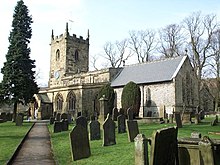Eyam is a village in the Derbyshire Dales that lies within the Peak District National Park. Eyam has many Plague-related places of interest.
It is pronounced "Eem".
Understand
[edit]
Eyam was a good place to be a church minister, provided you preached and prayed for the right people: around it were lead mines, and the vicarage took a comfortable income from these. In 1660 Britain shook off its 11-year experiment with being a republic, King Charles II was restored to the throne, and all Church of England ministers were required to pray for their gracious ruler. Most did so, but there were many standouts, such as Thomas Stanley the Puritan minister of Eyam. As a result he was ejected from his ministry and vicarage, and lived out his days in a righteous sulk in a cabin at the edge of the village. He was replaced by Rev William Mompesson, who owed his appointment to his zeal for the monarchy, which did not much endear him to his flock.
In early 1665 plague broke out in London. This was the flea-borne “bubonic” plague with a death rate of 30%; its later human-to-human “pneumonic” phase carried a death rate of 90%. Even so it was less lethal than medieval plagues but was dubbed “The Great Plague” since these were early modern times with a literate society, and with detailed contemporary accounts by Samuel Pepys, Daniel Defoe and John Gaunt. Plague spread to the larger towns, which in that pre-industrial era were wool-processing and market towns such as Norwich; the Midlands remained rural and were little affected. Nevertheless by summer it reached Eyam, it’s said from fleas in a bale of cloth, which is plausible but we’ll never know.
Eyam then suffered terribly from plague in the late summers of 1665 and of 1666. The village became famous because it isolated itself, an early example of cordon sanitaire, at the instigation of Rev Mompesson who (realising his unpopularity) allied with the former Rev Stanley. Of 700 residents, about a third died of plague, in line with the general bubonic mortality rate.
This means that measures to control spread within the village (which might now be called “social distancing”, eg holding church services in a wide-open space) were ineffective. It is unclear what effect they had on spread to surrounding villages, which was the quixotic rationale for the isolation. Many towns closer to London saw little illness in spite of an influx of the decamping wealthy and political classes (eg royal court and parliament). But they resolutely kept away the poorer sort of refugees, who found themselves marooned in the wastelands to die as much from starvation as from plague. In Sept 1666 the Great Fire of London swept away that medieval city, to be replaced by the modern capital further upriver at Westminster, and away too in the fire went many records of those times.
Get in
[edit]The nearest railway station is Chesterfield on the main line between Sheffield, Nottingham and London St Pancras, with trains at least twice an hour. However for onward transport, better to go to Sheffield Interchange, whence Bus 65 runs every two hours to Eyam, taking 70 min and continuing to Tideswell and Buxton.
Hulleys Bus 275 from Sheffield runs to Eyam and continues to Bakewell twice Monday to Saturday.
Get around
[edit]The village is small enough for walking.
See
[edit]

- 1 Eyam Hall Manor House. A manor house managed by the National Trust. Building and gardens open from Mar to Nov from Wednesday to Sundays.
- 2 Plague Cottages, Church Street. Original cottages dating from the 17th century during the plague outbreak.
- 3 Eyam Church, Church Street.
- 4 Eyam Hall Craft Centre.
- Eyam's Plague-related sites of interest include the Boundary Stone in the fields between Eyam and Stoney Middleton in which money, usually soaked in vinegar, which was believed to kill the infection, was placed in exchange for food and medicine. It is just one of several 'plague stones' marking the boundary that should not be crossed by either inhabitant or outsider. Another site is the isolated enclosure of the Riley graves mentioned above, now under the guardianship of the National Trust.
Do
[edit]- 1 Eyam Museum. 10AM-4:30PM. Dedicated to the story of Eyam's isolation and sacrifice in the face of the bubonic plague. £2.50 adults, £2 children and £7 for families.
- Carnival Week & Annual Sheep Roast. Festival held during the last week of August.
Buy
[edit]Eat
[edit]- 1 The Miners Arms, Water Lane, ☏ +44 1433 630853. A pub built in 1630. Food and bed & breakfast.
- 2 Village Green Tea Room, The Square, ☏ +44 1433 631293.
Drink
[edit]Sleep
[edit]- 1 YHA Youth Hostel, Hawkhill Road, ☏ +44 845 371 9738.
- 2 Crown Cottage B&B, Main Road, ☏ +44 1433 630858.
Connect
[edit]As of March 2024, Eyam and its approach roads have 4G from EE, Three and Vodafone, but no signal from O2. 5G has not reached this area.


